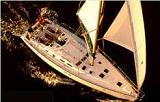Annapolis is the capital of the US state of Maryland. It is situated on the Chesapeake Bay at the mouth of the Severn River, 26 miles south of Baltimore and about 29 miles east of Washington. At 38°58' N, 76°30' W
History
A settlement named Providence was founded on the north shore of the Severn River in 1649 by Puritan exiles from Virginia. The settlers later moved to a better-protected harbor on the south shore, initially named "Town at Proctor's," then "Town at the Severn," and later "Anne Arundel's Towne", after the wife of Lord Baltimore who died soon afterwards. The city became very wealthy through the slave trade.
In 1694, soon after the overthrow of the Catholic government of the lord proprietor, Sir Francis Nicholson moved the capital of the royal colony there and named the town Annapolis after Princess Anne, soon to be the Queen of Great Britain; it was incorporated as a city in 1708.
From the middle of the 18th century until the American Revolutionary War, Annapolis was noted for its wealthy and cultivated society. It declined rapidly after Baltimore, with its deeper harbor, was made a port of entry in 1780. Water trades such as oyster-packing, boatbuilding and sailmaking became the city's chief industries. Currently, Annapolis is home to a large number of recreational boats that have largely replaced the seafood industry in the city.
During the Civil War, a Parole Camp was set up in Annapolis. As the war continued, the camp expanded to a larger location just outside of the city. The area is still referred to as Parole. Wounded Union soldiers and Confederate prisoners were brought by sea to a major hospital in Annapolis.
Sightseeing and Things to do
Annapolis has many 18th century houses. The names of several of the streets—King George's, Prince George's, Hanover, and Duke of Gloucester, date from colonial days.
The Maryland State House is the oldest in continuous legislative use in the United States. Construction started in 1772, and the Maryland legislature first met there in 1779. It is topped by the largest wooden dome built without nails in the country. It was in the Maryland state house that George Washington famously resigned his commission before the Continental Congress on December 23, 1783
The United States Naval Academy was founded in 1845 on the site of Fort Severn, and now occupies an area of land reclaimed from the Severn River next to the Chesapeake Bay.
The Banneker-Douglass Museum is located in the historic Mount Moriah Church at 87 Franklin Street, documents the history of African Americans in Maryland. Museum offers free admission, educational programs, rotating exhibits, and a research facility.
Hammond-Harwood House originally belonged to Matthias Hammond, and has now been restored. Tours are now offered.
The Kunta Kinte - Alex Haley memorial is located on downtown Annapolis, right on the harbor. It commemorates the place of arrival of Alex Haley's African ancestor, Kunta Kinte. The story of Kunta Kinte is related in Alex Haley's book Roots.
Weather
Annapolis lies within the humid subtropical climate zone, with hot summers and cool winters. Low elevation and proximity to the Chesapeake Bay give the area more moderate temperatures, with warmer winter temperatures and cooler summer temperatures than locations further inland, such as Washington, DC.
Reports on harbors and marinas in Maryland can be found here
Weather for the Yacht Charter Area of Annapolis



















